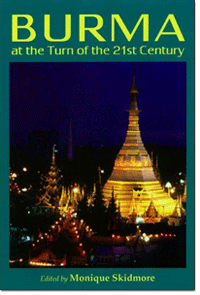
| By BERTIL LINTNER | JULY, 2006 - VOLUME 14 NO.7 |
An academic study of
 |
|
Burma at the Turn of the 21st Century, edited by Monique Skidmore, University of Hawaii Press, 2005. P304 |
Burma at the Turn of the 21st Century purports to be “the first collection of essays about everyday life in
But it is, nevertheless, a book well worth reading. It is divided into four parts, the first covering “spirituality, pilgrimage and economics,” the second “political and moral legitimation,” then “public performance” and ending with a one-piece contribution on the issue of “the domestic domain.” All a bit fluffy, but Gustaaf Houtman’s chapter on the personality cult surrounding Aung San Suu Kyi, and Jennifer Leehey’s account of the media and literary life in contemporary Burma stand out as excellent studies of issues that really matter.
Keiko Tosa’s chapter about the importance of rumors, and superstition, is also interesting. In 1991, for instance, people believed that fortune tellers had predicted that a woman would take a position of leadership. Then, intelligence chief Maj-Gen Khin Nyunt—described erroneously by many as a “pragmatist” and “moderate”—dressed up like a female actor and climbed up on a hilltop. His subordinates, the rumor went, called out three times to him, ‘Ma Ma Nyunt’ (elder sister Nyunt), to which he replied, ‘shin?’ (the word for “you” in female speech), before turning around three times.
At about the same time, then junta leader Gen Saw Maung attempted to accentuate his own chance of success by associating himself with an ancient Burmese king, Kyansittha, because that name brought together the words for “military” (sittha) and the wish to “survive or remain” (kyan). On another occasion, leaders of the armed forces together with senior Buddhist monks flew over
Comical as these examples may sound, they show how important traditional beliefs are in a Burmese context, for the men in power as well as the population at large. Tragically, they also prove that the people of
In a more down-to-earth way, Leehey describes how that power works in her chapter about
But despite the generals’ firm grip on power, Houtman argues that their “authoritarian instruments have failed to create enduring structures of state.” Power by the gun and personality is the rule of the game in
According to Houtman, the importance of personalities dominates even the democratic movement and its foreign supporters—and here no-one is more important than Aung San Suu Kyi. She has been likened to a “female bodhisattva” by her countrymen, and called “